For our tour description, itinerary,
past triplists, dates, fees, and more, please VISIT OUR TOUR PAGE.
See this triplist in printable PDF format with media only on
page 1.
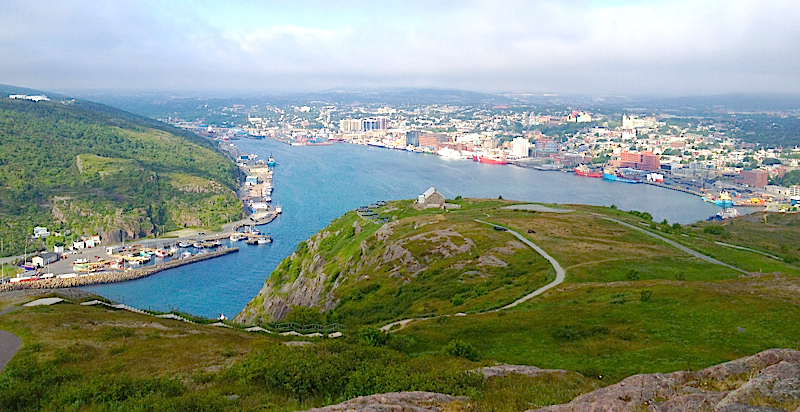
A view of the
picturesque capital of Newfoundland, St John's, from the top
of Signal Hill. (Photo by guide Chris Benesh)
This year's Newfoundland & Nova Scotia trip was a lot of
fun, despite one significant hitch that was beyond our
control. We started off our adventure in St. John's, a
picturesque port city in Newfoundland. Here, most views are
spectacular, and we were able to enjoy them from such sites as
Signal Hill and Cape Spear, the easternmost point of land in
North America. We ventured south of town to Bay Bulls, where
we took a boat out to Witless Bay where we enjoyed the
spectacle of many thousands of birds swirling in and out of
the fog and mist near Gull and Green islands. The sights,
sounds, and yes, smells, were unforgettable. Dominating the
scene were thousands of Atlantic Puffins, Common Murres,
Black-legged Kittiwakes, and hundreds of regal Razorbills. We
also enjoyed a trip out along the road to historic Cape Race,
where we encountered Willow Ptarmigan and a couple of
Short-eared Owls that really performed well in front of us. It
was from here that distress signals from the Titanic (sinking
nearly 375 miles away) first reached shore back in 1912.
Later the same day, we learned of our own ship disaster, that
the ferry scheduled to take us to Nova Scotia late the
following day was still out of service. This meant we had some
quick rescheduling to do. We headed to Cape St. Mary's for a
fantastic afternoon visit with the Northern Gannet colony. No
one will soon forget the sight of these birds zooming in and
out of the fog. The following day, we traveled across
Newfoundland, arriving at Port aux Basques in time for dinner
and a quick sleep. We then steamed across the Cabot Strait,
arriving mid-morning in North Sydney, (Cape Breton) Nova
Scotia. After grabbing a tasty lunch, we headed to Morien Bar
to do a bit of shorebirding (nice view of Hudsonian Godwit) as
well as a visit to scenic Louisbourg Harbour.
The following day we visited the Cape Breton Highlands, where
as good as the birds were, they took a back seat to a few of
the wonderful marine mammals we saw on our boat trip out of
Pleasant Bay. We encountered pods of Long-finned Pilot Whales,
some with Atlantic White-sided Dolphins, had a close encounter
with a couple of Humpback Whales, and saw lots of curious Gray
Seals. On our way off of Cape Breton Island, we stopped at the
Canso Causeway to watch the spectacle of plunge-diving
Northern Gannets and a couple of close Minke Whales. Then it
was on to a splendid beach where we strolled along the shore
to enjoy a small group of Piping Plovers.
Our last birding destination was Liscombe Lodge, and we had
some nice encounters there. Topping the nice birding was the
young Black-backed Woodpecker that came in to investigate us,
and the American Mink that trotted across the lodge grounds in
front of us. The stretch of the Glen Elg-Waternish road we
covered was also quite enjoyable, complete with some stunning
Evening Grosbeaks. Finally, on our way to Halifax, we made a
final stop to pick up the Acadian subspecies of Nelson's
Sparrow. A great way to wrap up our visit to northeastern
Canada.
Thanks to our driver, Fred, who took such good care of us
during the trip (not to mention becoming a fledgling birder
along the way). Also, thanks to Catherine & Paul Barrett
who opened up their home and feeders for us. Finally, thanks
to all of you for making the trip such a special one. I had a
great time traveling around with all of you. Until next time,
good birding out there!
--Chris
For more information about this tour, including future
departures, visit our website at www.fieldguides.com.
And to see this same triplist online, go to http://www.fieldguides.com/triplists/nsn12LIST.pdf
and you will find the list in its entirety.
KEYS FOR THIS LIST
One of the following keys may be shown in brackets for
individual species as appropriate: * = heard only, I =
introduced, E = endemic, N = nesting, a = austral migrant, b =
boreal migrant
Anatidae (Ducks, Geese, and Waterfowl)
CANADA GOOSE (Branta canadensis)
WOOD DUCK (Aix sponsa)
AMERICAN WIGEON
(Anas americana)
AMERICAN BLACK
DUCK (Anas rubripes)
MALLARD (Anas platyrhynchos)
GREEN-WINGED TEAL
(AMERICAN) (Anas crecca
carolinensis)
RING-NECKED DUCK
(Aythya collaris)
GREATER SCAUP
(Aythya marila)
COMMON EIDER
(ATLANTIC) (Somateria
mollissima dresseri)
COMMON GOLDENEYE
(Bucephala clangula)
COMMON MERGANSER
(Mergus merganser)
Phasianidae (Pheasants, Grouse, and
Allies)
WILLOW PTARMIGAN (Lagopus lagopus)
Gaviidae (Loons)
COMMON LOON (Gavia immer)
Procellariidae (Shearwaters and Petrels)
NORTHERN FULMAR (Fulmarus glacialis)
GREAT SHEARWATER
(Puffinus gravis)
SOOTY SHEARWATER
(Puffinus griseus)
MANX SHEARWATER
(Puffinus puffinus)
Hydrobatidae (Storm-Petrels)
WILSON'S STORM-PETREL (Oceanites oceanicus)
Sulidae (Boobies and Gannets)
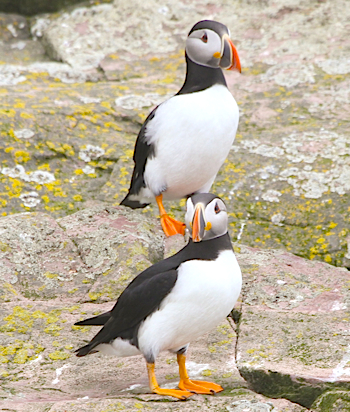
The trip out to
Witless Bay was one of the tour highlights, thanks in
large part to the incredible numbers of comical Atlantic
Puffins seen. (Photo by guide Chris Benesh)
NORTHERN GANNET (Morus bassanus)
Phalacrocoracidae (Cormorants and Shags)
DOUBLE-CRESTED CORMORANT (Phalacrocorax auritus)
GREAT CORMORANT
(Phalacrocorax carbo)
Ardeidae (Herons, Egrets, and Bitterns)
GREAT BLUE HERON (Ardea herodias)
Pandionidae (Osprey)
OSPREY (Pandion
haliaetus)
Accipitridae (Hawks, Eagles, and Kites)
BALD EAGLE (Haliaeetus
leucocephalus)
NORTHERN HARRIER
(Circus cyaneus)
SHARP-SHINNED HAWK
(Accipiter striatus)
NORTHERN GOSHAWK
(Accipiter gentilis)
BROAD-WINGED HAWK
(Buteo platypterus)
Falconidae (Falcons and Caracaras)
AMERICAN KESTREL (Falco sparverius)
MERLIN (Falco columbarius)
Charadriidae (Plovers and Lapwings)
PIPING PLOVER (Charadrius melodus)
Scolopacidae (Sandpipers and Allies)
SPOTTED SANDPIPER (Actitis macularius)
GREATER YELLOWLEGS
(Tringa melanoleuca)
WILLET (Tringa semipalmata)
LESSER YELLOWLEGS
(Tringa flavipes)
WHIMBREL (Numenius phaeopus)
HUDSONIAN GODWIT
(Limosa haemastica)
SHORT-BILLED
DOWITCHER (Limnodromus
griseus)
WILSON'S SNIPE
(Gallinago delicata) [*]
Laridae (Gulls, Terns, and Skimmers)
BLACK-LEGGED KITTIWAKE (Rissa tridactyla)
RING-BILLED GULL
(Larus delawarensis)
HERRING GULL
(AMERICAN) (Larus argentatus
smithsonianus)
GREAT BLACK-BACKED
GULL (Larus marinus)
COMMON TERN
(Sterna hirundo)
ARCTIC TERN
(Sterna paradisaea)
Alcidae (Auks, Murres, and Puffins)
COMMON MURRE (Uria aalge)
THICK-BILLED MURRE
(Uria lomvia)
RAZORBILL (Alca torda)
BLACK GUILLEMOT
(Cepphus grylle)
ATLANTIC PUFFIN
(Fratercula arctica)
Columbidae (Pigeons and Doves)
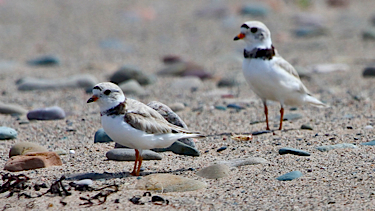
Four adult Piping
Plovers were a nice find at Pomquet, Nova Scotia; this is
an endangered species in Canada, declining in part due to
the heavy disturbance to their preferred beach nesting
areas. (Photo by guide Chris Benesh)
ROCK PIGEON (Columba livia) [I]
MOURNING DOVE
(Zenaida macroura)
Strigidae (Owls)
SHORT-EARED OWL (Asio flammeus)
Caprimulgidae (Nightjars and Allies)
COMMON NIGHTHAWK (Chordeiles minor)
Trochilidae (Hummingbirds)
RUBY-THROATED HUMMINGBIRD (Archilochus colubris)
Alcedinidae (Kingfishers)
BELTED KINGFISHER (Megaceryle alcyon)
Picidae (Woodpeckers)
DOWNY WOODPECKER (Picoides pubescens)
HAIRY WOODPECKER
(Picoides villosus)
BLACK-BACKED
WOODPECKER (Picoides arcticus)
NORTHERN FLICKER
(Colaptes auratus)
Tyrannidae (Tyrant Flycatchers)
EASTERN WOOD-PEWEE (Contopus virens)
YELLOW-BELLIED
FLYCATCHER (Empidonax
flaviventris)
ALDER FLYCATCHER
(Empidonax alnorum)
LEAST FLYCATCHER
(Empidonax minimus)
Vireonidae (Vireos)
BLUE-HEADED VIREO (Vireo solitarius)
RED-EYED VIREO
(Vireo olivaceus)
Corvidae (Crows, Jays, and Magpies)
GRAY JAY (Perisoreus
canadensis)
BLUE JAY (Cyanocitta cristata)
AMERICAN CROW
(Corvus brachyrhynchos)
COMMON RAVEN
(Corvus corax)
Alaudidae (Larks)
HORNED LARK (Eremophila alpestris)
Hirundinidae (Swallows)
TREE SWALLOW (Tachycineta bicolor)
BARN SWALLOW
(Hirundo rustica)
Paridae (Chickadees and Tits)
BLACK-CAPPED CHICKADEE (Poecile atricapillus)
Sittidae (Nuthatches)
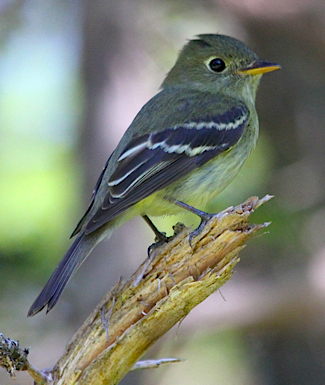
Empid
identification is pretty straightforward in Newfoundland,
where only 2 species (Alder and Yellow-bellied) occur as
regular breeding birds, and they are quite distinct from
each other. This is a Yellow-bellied Flycatcher. (Photo by
guide Chris Benesh)
RED-BREASTED NUTHATCH (Sitta canadensis)
WHITE-BREASTED
NUTHATCH (Sitta carolinensis)
Certhiidae (Treecreepers)
BROWN CREEPER (Certhia americana)
Troglodytidae (Wrens)
WINTER WREN (Troglodytes hiemalis hiemalis)
Regulidae (Kinglets)
GOLDEN-CROWNED KINGLET (Regulus satrapa)
RUBY-CROWNED
KINGLET (Regulus calendula)
Turdidae (Thrushes and Allies)
SWAINSON'S THRUSH (Catharus ustulatus)
HERMIT THRUSH
(Catharus guttatus)
AMERICAN ROBIN
(Turdus migratorius)
Sturnidae (Starlings)
EUROPEAN STARLING (Sturnus vulgaris) [I]
Motacillidae (Wagtails and Pipits)
AMERICAN PIPIT (Anthus rubescens)
Bombycillidae (Waxwings)
CEDAR WAXWING (Bombycilla cedrorum)
Parulidae (New World Warblers)
OVENBIRD (Seiurus
aurocapilla)
NORTHERN
WATERTHRUSH (Parkesia
noveboracensis)
BLACK-AND-WHITE
WARBLER (Mniotilta varia)
TENNESSEE WARBLER
(Oreothlypis peregrina)
NASHVILLE WARBLER
(Oreothlypis ruficapilla)
MOURNING WARBLER
(Geothlypis philadelphia)
COMMON
YELLOWTHROAT (Geothlypis
trichas)
AMERICAN REDSTART
(Setophaga ruticilla)
NORTHERN PARULA
(Setophaga americana)
MAGNOLIA WARBLER
(Setophaga magnolia)
BLACKBURNIAN
WARBLER (Setophaga fusca)
YELLOW WARBLER
(Setophaga petechia)
CHESTNUT-SIDED
WARBLER (Setophaga
pensylvanica)
BLACKPOLL WARBLER
(Setophaga striata)
BLACK-THROATED
BLUE WARBLER (Setophaga
caerulescens)
YELLOW-RUMPED
WARBLER (Setophaga coronata)
BLACK-THROATED
GREEN WARBLER (Setophaga
virens)
CANADA WARBLER
(Cardellina canadensis)
Emberizidae (Buntings, Sparrows and
Allies)
SAVANNAH SPARROW (Passerculus sandwichensis)
NELSON'S SPARROW
(ATLANTIC COAST) (Ammodramus
nelsoni subvirgatus)
FOX SPARROW (RED)
(Passerella iliaca iliaca)
SONG SPARROW
(Melospiza melodia)
SWAMP SPARROW
(Melospiza georgiana)
WHITE-THROATED
SPARROW (Zonotrichia
albicollis)
DARK-EYED JUNCO
(SLATE-COLORED) (Junco
hyemalis hyemalis)
Icteridae (Troupials and Allies)
RED-WINGED BLACKBIRD (Agelaius phoeniceus)
COMMON GRACKLE
(Quiscalus quiscula)
BROWN-HEADED
COWBIRD (Molothrus ater)
Fringillidae (Siskins, Crossbills, and
Allies)
PINE GROSBEAK (Pinicola enucleator)
PURPLE FINCH
(Carpodacus purpureus)
WHITE-WINGED
CROSSBILL (Loxia leucoptera)
[*]
PINE SISKIN
(Spinus pinus)
AMERICAN GOLDFINCH
(Spinus tristis)
EVENING GROSBEAK
(Coccothraustes vespertinus)
SNOWSHOE HARE
(Lepus americanus)
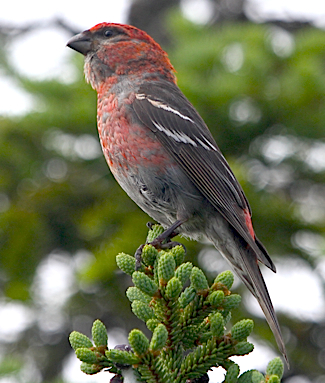
One of the
highly-prized birds of the northern boreal forests, a
beautiful male Pine Grosbeak. (Photo by guide Chris
Benesh)
PLAIN EASTERN CHIPMUNK (Tamias striatus)
RED SQUIRREL
(Tamiasciurus hudsonicus)
MEADOW VOLE
(Microtus pennsylvanicus)
WHITE-BEAKED
DOLPHIN (Lagenorhynchus
albirostris)
ATLANTIC
WHITE-SIDED DOLPHIN (Lagenorhynchus
acutus)
LONG-FINNED PILOT
WHALE (Globicephala melas)
COMMON MINKE WHALE
(Balaenoptera acutorostrata)
FIN WHALE (Balaenoptera physalus)
HUMPBACK WHALE
(Megaptera novaeangliae)
AMERICAN MINK
(Mustela vison)
GRAY SEAL (Halichoerus grypus)
WHITE-TAILED DEER
(Odocoileus virginianus)
MOOSE (Alces alces)

Our boat trip out
of Pleasant Bay, on Cape Breton, was especially fantastic
for a variety of marine mammals, including these
Long-finned Pilot Whales. (Photo by guide Chris Benesh)
CARIBOU (Rangifer
caribou)
Totals for the tour: 120 bird taxa and 15 mammal taxa






